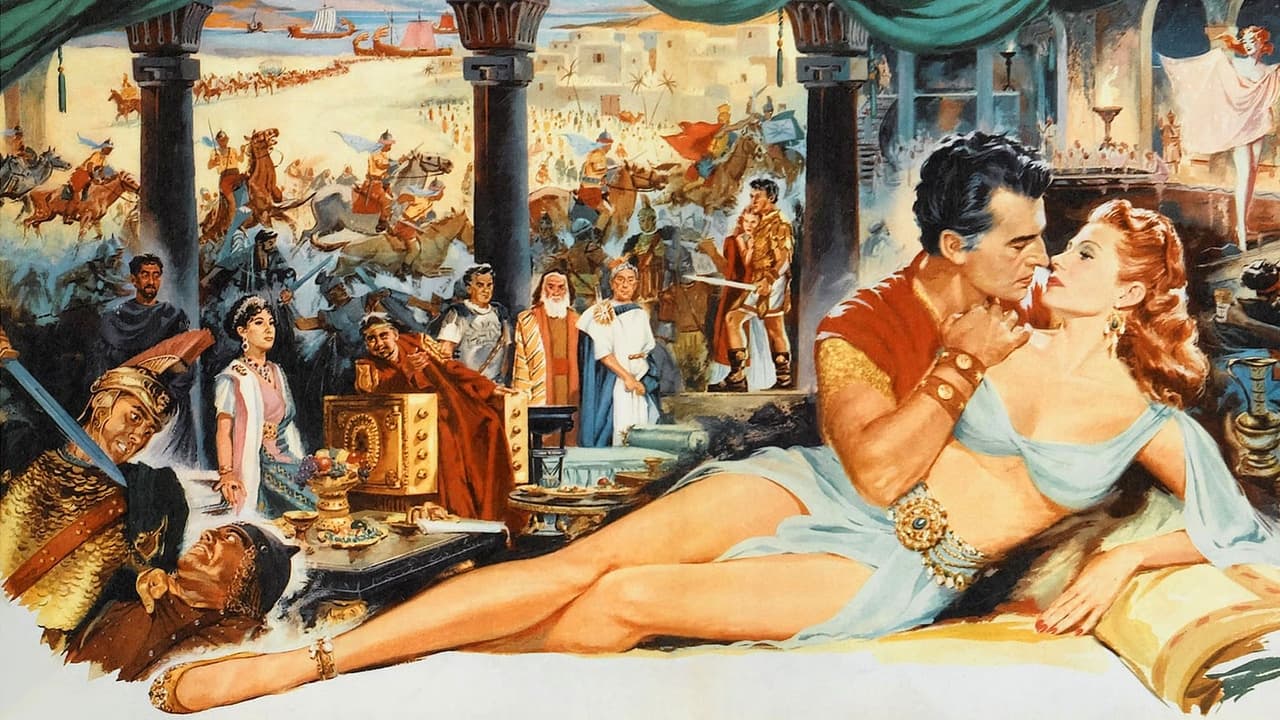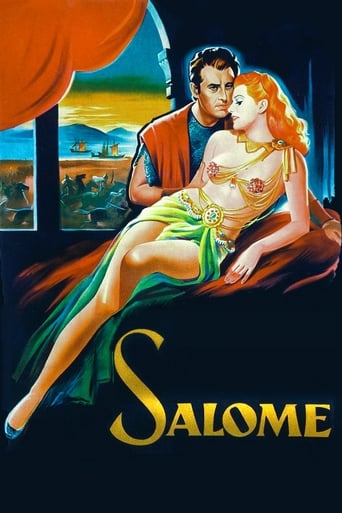

John the Baptist (Alan Badel) denounces the rule of King Herod (Charles Laughton) and the scheming Queen Herodias (Judith Anderson). Herod was her husband's brother. Emperor Tiberius Caesar dismisses Princess Salome (Rita Hayworth) from Rome. She returns home to her mother Herodias with Roman soldier Commander Claudius (Stewart Granger). Herod lusts after her. Salome attends John the Baptist speaking and is taken with him.This is an old-fashion Biblical epic with big sets and old-fashion big acting. The acting is very broad compared to modern sensibilities. The veteran duo of Laughton and Anderson is compelling. Hayworth's acting is rarely subtle. Badel does a lot of staring skyward. Unlike some of the more iconic Biblical epics, this one doesn't have the big action scenes unless the Dance of the Seven Veils is an action scene to you. Rita Hayworth throws everything into the dance. Maybe she's throwing too much into it. Some of the moves are too hard and not sensual enough. I like some of the old epics but this is not one of them.
... View MoreThough the movie is known for star Rita Hayworth's "dance of the seven veils," the over-the-top performances of Sir Charles Laughton and Dame Judith Anderson are worth the price of admission. The pair play Herod and Herodias, two of the other central figures in the eventual beheading of John the Baptist, played to the hilt by Alan Badel.Laughton alternates between seriousness and buffoonery as the king who condemns the Baptist to death at the request of his wife. Anderson plays his wife in the same sinister wizardry as she had done earlier as "Mrs. Danvers" in "Rebecca." These are two pros that always made acting mincemeat of anyone around them.Hayworth looks good in her royal garb and does well in the role of the unwitting temptress, used by her mother to swing the tide against "The Baptist." Co-star Stewart Granger is along for the ride as Hayworth's love interest.Composer Daniele Amfitheatrof's music for the celebrated dance is quite memorable, made the more by Hayworth's foot and body work.
... View MoreWhile this film does vary from the biblical storyline, it's worth watching for Rita alone. She's a vision in all her scenes and very good in her part, culminating in her 'Dance of the Seven Veils', which is a treasure. {I only wish it wasn't montaged with the death of the Baptist.} Rita never looked lovelier than she does here and her Jean Louis costumes are all drop-dead gorgeous. Stewart Granger is pretty good, better than usual, he and Rita having good chemistry here. It's well cast, with actors Charles Laughton and Dame Judith Anderson both excellent as King Herod and Queen Herodias. Arnold Moss is slithering as the evil adviser to Queen Herodias, though Alan Badel as John the Baptist seems more like a wild-eyed madman than a holy prophet. Though there are some filler segments that are not up to the rest of the film, still I think it's excellent entertainment.
... View MoreAlthough other films from the same period might be expected to receive a higher priority because they remain more significant today, it seems amazing that this film has never been released as a DVD. Salome is highly viewable, and anyone simply wanting to pass an evening by watching a light entertaining film without regard to its message or social significance would probably find it an excellent choice. Such films are among the most successful in video rental stores or as casual purchases from store displays - consequently they bring in the greatest returns for companies creating new DVD's from old films and are often selected in preference to much more significant works.What does Salome have going for it?. Firstly a good Technicolor print of the type which provides endlessly enjoyable images of the seas, skies and scenery so plentiful in the Mediterranean. Next a very popular duration of around 100 minutes, a story which is widely known and a one word title equally readily recognised. Thirdly a cast largely composed of great Hollywood stars of the period - a major selling point usually far more important than the filmscript, direction or historical accuracy; and finally an electrifying near striptease performance by a star who has been referred to as the Hollywood love goddess of the period. To set against all this were the very poor reviews by most critics who condemned it for gross overacting, poor dialogue, unimaginative direction and historical inaccuracy - all of which experience suggests is of less importance than the cast for most viewers (even those who study the critics), when they are simply looking for an enjoyable and relaxing evening.Furthermore some of these criticisms are not easily sustained. 'Overacting' is a qualitative term which first became important when the introduction of talkies in the 1930's made the exaggerated actions and gestures of the silent era no longer necessary. Stage actors are trained to overact so the distant members of their audience seated far away 'up in the gods' can better follow what is going on. Done carefully this type of overacting can be very effective in films with rather melodramatic story lines, and is often referred to as 'chewing up the scenery'. There is a lot of this in Salome, not only from John the Baptist but also from both Herod and Herodias. Watching Charles Laughton, as a very lecherous Herod, lasciviously rolling his eyes and drooling at the mouth when Salome dances is one of the great joys of this film. It is true that Rita Hayworth was probably too old to play a character historically believed to have been so much younger, and she certainly did not look the part of a Semitic princess, but she was trained as a dancer from infancy and it is unlikely that the film would have the same appeal today if any other Hollywood star of the period had been given the role. Historical inaccuracies are much more controversial. I take a very strong objection to incorrect representations of what is factually established history unless it is made clear that this is being done. Here however historical records seem to be rather limited and not entirely self consistent, so some judgment is called for. Most of what we believe we know about Salome probably comes from records that are more literary than historical. For hundreds of years much current literature comprised re-writing and fleshing out known stories which might have originated as oral history, legend, myth or pure fiction. In this case an additional complication is that the most widely known contemporary reference come from the Bible rather than from a work solely written as history - something that often leads to public reactions based more on emotion than on fact. Herod, Herodias and Herodias's daughter are well authenticated historical characters, but doubts have even been raised as to whether the latter was actually named Salome (some sources refer to her having the same name as her mother). History points to her age at the time as being 13 or 14 but this is by inference rather than definite records. The account of Salome dancing before Herod occupies about 200 words in each of the gospels of Mark and Matthew in the Bible. There is also a brief historical record of this dance and its outcome written by the Roman-Jewish historian Josephus. The story in this film reverses the biblical story which indicates that Salome had no idea what reward to seek from Herod after dancing for him, but at the request of her mother agreed to ask for John's head. The reversal was demanded by a Columbia Studio head who did not want his star tagged with the label of a very bad girl, but historically it can also be found in Jules Massenet's opera "Herodiade". In a film intended purely as a piece of entertainment this reversal would be justifiable artistic licence so long as the change from the normally accepted story was clearly indicated. Since this was not done, the film has been mercilessly but rather unfairly shredded by critics and viewers ever since. Nobody today would view it to learn the story and for those merely seeking an enjoyable evening's viewing, it is inconsequential. If a similar film had depicted a legend about which little was known historically, there would have been much less controversy and, despite all its faults, the film would probably have remained much more highly regarded right up to today (with copies on DVD readily available in almost every video store). Anyone who wishes to view a more structured reconstruction of this story should watch the fine Ken Russell film based on the play by Oscar Wilde (or even Nazimova's 1923 silent film), but for an evening's light, enjoyable entertainment without heavy psychological musings choose this 1953 film.
... View More